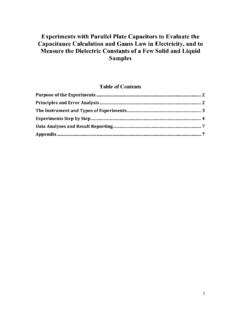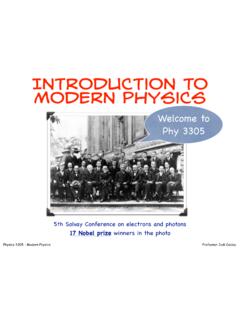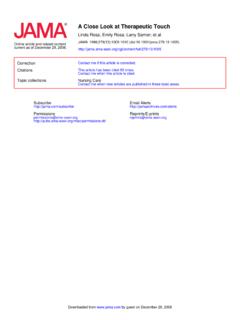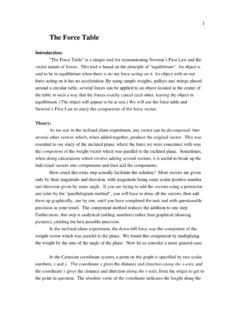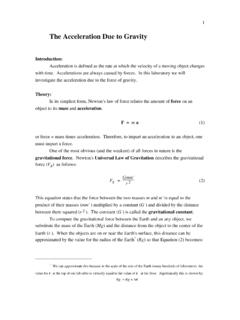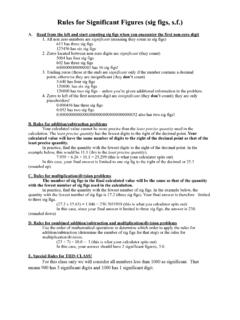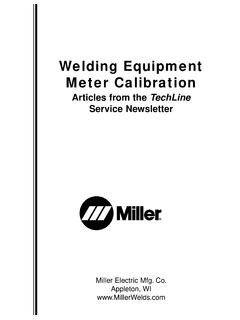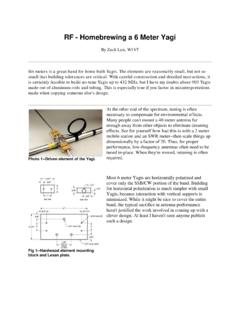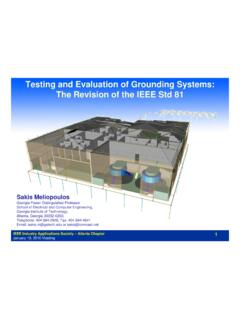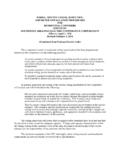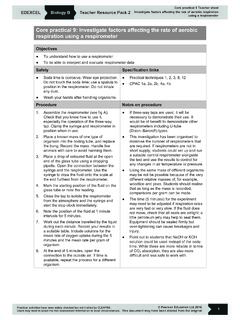Transcription of Rotational Equilibrium - SMU
1 1 Rotational EquilibriumIntroduction:In the past experiments, we have observed several cases of Equilibrium , that is, thestate for which there is no net force on an object. We noted that in this case, the linearacceleration of the object was zero. All of the experiments have dealt with forces whichcaused the objects involved to move in a straight line. In the real world objects are notsimply masses at a point but, rather, they have finite volumes with a total mass and acenter of gravity. Not only can these objects move in a straight line, but they can rotatearound a fixed axis similar to the way in which the Earth rotates on its axis. The speed atwhich an object rotates (in radians per second) is called the angular velocity ( ) and therate of change of the angular velocity is called the angular acceleration ( ).
2 Whereas aforce is responsible for imparting a linear acceleration, another quantity called torque ( )is responsible for angular acceleration. The torque is defined as the product of the forceand its lever arm. The lever arm is defined as the distance (l) perpendicular to the forcebetween the force and the axis of rotation. The diagram below illustrates the torqueexerted on a rod of length R about a pivot point on one end. = FllFRThe two cases drawn above have the same torque. The drawing on the rightshows how to find the lever arm when the force is not perpendicular to the rod. The casein the diagram is similar to the use of a wrench in tightening a bolt. If the force were inthe same direction as the wrench, the bolt would never turn.
3 If the force wasperpendicular to the wrench, then l would equal R and the torque would be greater thanin the Equilibrium is defined as the state of a system for which the totalangular acceleration is zero. Since it is the torque which is responsible for this2acceleration, a total torque of zero is also required for a system to be in objective of this experiment is to consider the effects of various torques on ameter stick. You will place the meter stick on a fulcrum, which is placed at the center ofgravity of the meter stick. You will then add different weights on either side of thefulcrum at different distances until the meter stick is balanced and level. At this point wewill have achieved static Rotational Equilibrium , and all the clockwise (cw) torques (thosewhich tend to rotate it clockwise) and the counter-clockwise (ccw) torques will be W 21 =2 =l1W1 W 22lAfter this, we will place the fulcrum at some point away from the center of themeter stick and repeat the process.
4 Since all of the mass is effectively concentrated at thecenter of gravity, one must account for the torque resulting from gravity acting on themeter stick. Balancing the meter stick in this manner will make it possible to determine itsweight. Procedure:Part One1. Place the fulcrum knife-edge on the meter stick and clamp it at the 50 cm mark. Placethe fulcrum base on the corner of your table diagonally so that both ends clear the to see if the meter stick alone will balance in a level position. If not, make smalladjustments to the position of the fulcrum knife-edge until a level balance is the position of the knife-edge when a balance is achieved as the position of thecenter of mass of the meter Place a weight hanger on each side of the fulcrum and add a weight hook to the slot masses available, add about 200-250 g to one hook and 300-400 g to the3other.
5 Manipulate the position of both hangers until a level balanced Equilibrium Record the clockwise and counter-clockwise lever arms by measuring the distancebetween the knife-edge and weight-hooks (noting whether they are on the right or left ofthe knife-edge). Record the total mass hanging at each position. The total mass is thecombined mass of the weight hanger, the weight hook and the added weights. It may benecessary to use the triple beam balance to find this. Mark each hanger/hook with L or Rto indicate whether it is on the left or the Two4. Place the knife-edge about 20-30 cm from the end of the meter stick and place a singleweight hanger and weight hook on the short end of the stick.
6 Place slot masses on thishook until a level balanced Equilibrium is The balance can be refined by moving the knife-edge and changing the amount ofweight on the Record lcw and lccw by measuring the distance between the fulcrum knife-edge andthe weight hanger and the distance between the knife-edge and the recorded position ofthe center of mass. Record the total amount of mass needed to balance the weight of themeter Record the mass of the meter stick as measured with a triple beam balance. Recordthis below the table, in order to compare it to the value determined from the Three8. Without moving the knife edge, add a small weight to the end of the meter stick on thelong end. Balance this by adjusting the amount of weight and the short end until a balanceis achieved.
7 There are now three torques on the system. Draw a picture of the meterstick, measure and label the various weights and lever arms and calculate the :Calculate all weights in units of the data in Part 1, calculate the counter-clockwise and clockwise torquesinvolved. Are they near equal? Consider the number of significant the data in Part 2, calculate the torque from the hanging weight. Assumethe torque from the hanging weight is the equal and opposite to the torque created by thecenter of mass. Use these data to calculate the mass of the meter stick. Compare thiswith the value you measured on the triple-beam your solution for Part Two, calculate the torques for Part Three. Find theirsum, remembering that you subtract torques in opposite directions and add those in :Part One1.
8 Are the torques roughly equal? What does this tell you about the condition forequilibrium?2. To how many significant figures are the torques similar? What other values weremeasured to this degree of precision?Part Two3. How does the calculated mass compare to the mass of the meter stick found on thetriple beam balance?Part Three4. How did the set of three torques balance out?Error Analysis:Describe sources of error for this EquilibriumName:_____Station:____Section : _____Abstract:Part One:massweightl clockwisecounter-clockwisetotal torque:Calculations:Part Two:Read Carefully: In this part, one weight and both lever arms are measured. Assume thetorques (cw,ccw) to be equal. You are to calculate the second weight, which is theweight of the meter stick.
9 Label which weight is that of the meter clockwisecounter-clockwise6 Part Three:Label the meter stick below with the appropriate weights and lever arms for part three andcompute the individual and total torques. (Be sure to write in your numerical values withappropriate units.)Calculations:Conclusions:7 Error Analysis:Data Collection / Calculations (40%)Abstract / Conclusions (40%)Error Analysis (20%)Grade:9
